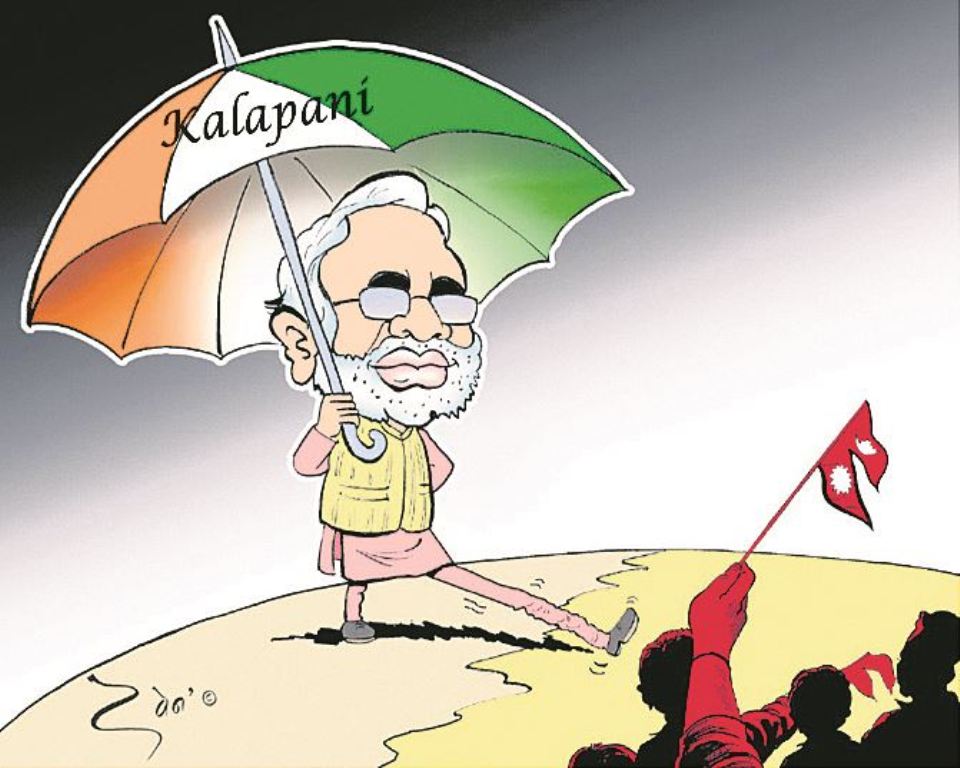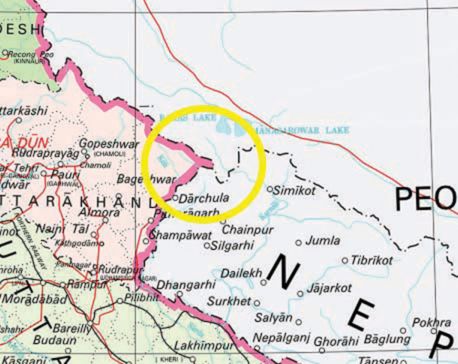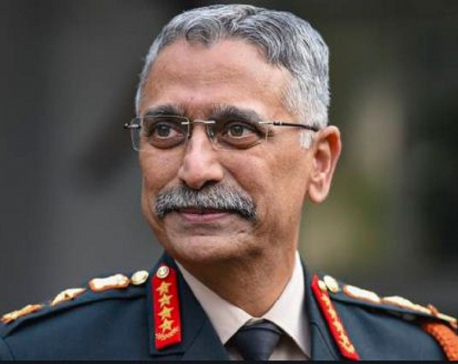
OR

Nepal should conduct bilateral negotiation with India in high gear
by presenting all the available evidences to end the border disputes
The inclusion of Kalapani land in the new official political map of India followed President Xi Jinping’s state visit to Mamallapuram of India for an informal summit meeting with Prime Minister Narendra Modi in October, 2019. Prior to this, both these leaders had made a joint statement without consulting Nepal in 2014 in Beijing stating that Lipulekh was their trade route which Nepal has been opposing. Such heavy-handed unilateral decisions have sparked stirring criticisms and controversies. And if the territorial disputes are not resolved it would have its overarching multifaceted impacts in Nepal-India relations. Britain, Nepal and India have the documented official evidences such as the Sugauli Treaty of 1816 for resolving the outstanding border disputes through bi or trilateral negotiations involving Britain, if necessary.
Nepal’s flimsiness in forestalling the management of its national territory bordering India over the period due to frequent political instabilities and leadership flaws over the period can be attributed to aggravation of the border disputes. Kalapani-Limpiyadhura (372 sq. kms) and Susta (145 sq. kms) are identified to be the most disputed areas between India and Nepal.
Also, there are an estimated 70 locations in 24 districts of Nepal bordering India where such land encroachments issues exist. India has been keeping its security personnel and troops in Nepal’s Kalapani since 1962 Sino-India War with the intent of having a close watch over Chinese movements on the border.
Ironically, on Indo-Nepal border disputes of such a tremendous magnitude, especially China and Britain seem to stand as ‘passive’ or silent observers. China’s indifference behind this might be due to expectation of maximizing its trade volumes with India and probably the hope that India would one day join its Belt and Road Initiative (BRI) in spite of the longstanding rivalry since Sino-India war and the underlying border disputes between the two. India seems to have been taking advantage of the evolving circumstance. Analysts suspect India’s bullying tactics on Nepal such as the torturous economic blockade of 2015 are guided by its ulterior motive that Nepal remained feeble politically, economically, socially and diplomatically. Nonetheless, lack of readiness on the part of leaders of federal Nepal in speeding up bilateral negotiations to settle territorial dispute is also responsible.
A few of the South Asian Association for Regional Cooperation (SAARC) countries have already been the victims of territorial encroachment. Nepal is probably the worst victim. Disputed Kashmir has been unilaterally annexed by India recently. Doklam dispute also makes Nepal extra alert about its land at tri-junctions such as Lipulekh Himalayan pass lying at the top of Kalapani. All these geo-political border disputes due to India’s hegemony and implicit territorial expansion strategy could ultimately put South Asia region at risk, inviting its ramifications in the global peace. Ending geopolitical violence is of critical need.
The discriminatory Citizenship Amendment Act (CAA) enacted on December 12, 2019 has given rise to anti-secularism along with divisive terms of ‘Hindi, Hindu and Hindutva’ ideology. Lax economic growth, coupled with ongoing Gorkhaland movement and the border disputes with Nepal as well as with China and Pakistan, could lead to the resurgence of claim by Nepal for ‘Greater Nepal,’ the territories Nepal lost to British East India Company in 1816. This could result in loss of peace and stability in the region. Ashok Swain, India-born renowned academic and professor at Department of Peace and Conflict Research at Uppsala University, Sweden has rightly said: “In this critically sensitive time of bilateral relationship, India’s ham-handed decision to put Kalapani in its new map is nothing but self-defeating”.
Any illegal annexation of territory also violates International Laws and UN Charter, Panchsheel principles, Nepal’s treaties with British East India Company of 1816, 1860 and 1875 and Indo-Nepal Peace and Friendship Treaty of 1950. Nepal has the evidence of land revenue certificates issued by Nepal to local inhabitants in the occupied territories. Besides, the first political map issued by British East India Company and the one India issued right after independence do not show Kalapani inside India.
The idea of greater Nepal includes territories from Tista River in the east to Kangada (Sutlej River) including Gorkha land and Sikkim in the West Bengal spanning 1,500 kms. The British India claimed these lands by covertly launching war against Nepal and imposing the Sugauli Treaty (1816). Under the cloak of intimidation, threat and coercion the Treaty of Sugauli 1816 was imposed on Nepal back then. Nepal could thus exercise the legal right to claim the lost territory of 58,000 sq. kms of Greater Nepal. Imposing a border change and illegal occupancy could have been truthfully and responsively ended just as British government returned Hong Kong in 1997 and Macau in 1999 to China, and British East India Company returned Banke, Bardia, Kailali and Kanchanpur districts to Nepal in 1857.
Animosity in age-old bilateral relations between India and Nepal might not escalate in the face of Nepal’s dependence on India, its lopsided approach toward China and the intensified Western interest of strategic cooperation with Nepal in its development.
But at a time when there is political stability with NCP-led majority government in place, Nepal should conduct bilateral negotiation with India in high gear by presenting all the available evidences to end the border disputes. Internationalizing border issue, seeking assistance from UN including International Court of Justice, Britain and International Boundaries Research Unit (IBRU) based in UK on Kalapani-Limpiyadhura and Lipulekh can be the last resort.
Likewise, Nepal may also appeal Non-resident Nepalis (NRNs), Gorkha forces serving in foreign armies including those in India for solidarity in this process.
The author writes on contemporary issues
You May Like This

Reclaiming our land
The Indo-Nepal border dispute at Limpiyadhura, Lipulekh and Kalapani is getting intense. Nepali Congress President Sher Bahadur Deuba has accused... Read More...

Indian Army chief's controversial remark on Lipu Lekh faces sharp criticism in Nepal
KATHMANDU, May 15: Indian Army Chief General MM Naravane on Friday accused Nepal of raising the Lipu Lekh issue at... Read More...

SC tells govt to explain encroachment by India
KATHMANDU, Nov 16: The Supreme Court on Friday sought an explanation from the government on encroachment of Nepal's territory by... Read More...







Just In
- NRB to provide collateral-free loans to foreign employment seekers
- NEB to publish Grade 12 results next week
- Body handover begins; Relatives remain dissatisfied with insurance, compensation amount
- NC defers its plan to join Koshi govt
- NRB to review microfinance loan interest rate
- 134 dead in floods and landslides since onset of monsoon this year
- Mahakali Irrigation Project sees only 22 percent physical progress in 18 years
- Singapore now holds world's most powerful passport; Nepal stays at 98th












Leave A Comment